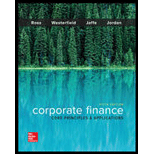
To discuss: The aspect measured by liquidity and the tradeoff faced by the firm between high and low liquidity levels.
Introduction:
The liquidity of an asset refers to its ease and quickness in converting itself into cash without any significant loss in value. Cash in hand, cash at bank, short-term investments, accounts receivable, and inventories are some of the examples of liquid assets displayed in the decreasing order of liquidity.
Explanation of Solution
Liquidity measures the following:
The liquidity measures the ease in converting an asset into cash without losing a significant portion of its value. Liquidity is very important for a firm. If a firm has a high liquidity, then it has a less risk of facing financial distress because the firm can easily convert its assets to pay off creditors.
The tradeoff faced by the firm:
Although, a higher liquidity is essential to a firm, it is not always favorable. The firm has to face a tradeoff between the high and low liquidity levels. If a firm holds excess cash in hand or bank, it would have a higher liquidity. However, this strategy is not favorable because the idle cash does not yield any return.
Similarly, if a firm invests all or most of the money in operating activities or investments, it will generate huge returns. However, this strategy will decrease the liquidity, and the firm might face financial distress. Hence, the firm has to maintain a tradeoff or balance between the liquidity levels. It cannot maintain too high or too low liquidity levels.
The liquidity measures the ease in converting the asset into cash without any significant loss in value. Very low liquidity levels will increase the risk of financial distress and very high liquidity levels will not yield any return on the cash. Hence, the firm has to face a tradeoff between the liquidity levels that it needs to maintain.
Want to see more full solutions like this?
Chapter 2 Solutions
Corporate Finance: Core Principles and Applications (Mcgraw-hill Education Series in Finance, Insurance, and Real Estate)
 Essentials Of InvestmentsFinanceISBN:9781260013924Author:Bodie, Zvi, Kane, Alex, MARCUS, Alan J.Publisher:Mcgraw-hill Education,
Essentials Of InvestmentsFinanceISBN:9781260013924Author:Bodie, Zvi, Kane, Alex, MARCUS, Alan J.Publisher:Mcgraw-hill Education,

 Foundations Of FinanceFinanceISBN:9780134897264Author:KEOWN, Arthur J., Martin, John D., PETTY, J. WilliamPublisher:Pearson,
Foundations Of FinanceFinanceISBN:9780134897264Author:KEOWN, Arthur J., Martin, John D., PETTY, J. WilliamPublisher:Pearson, Fundamentals of Financial Management (MindTap Cou...FinanceISBN:9781337395250Author:Eugene F. Brigham, Joel F. HoustonPublisher:Cengage Learning
Fundamentals of Financial Management (MindTap Cou...FinanceISBN:9781337395250Author:Eugene F. Brigham, Joel F. HoustonPublisher:Cengage Learning Corporate Finance (The Mcgraw-hill/Irwin Series i...FinanceISBN:9780077861759Author:Stephen A. Ross Franco Modigliani Professor of Financial Economics Professor, Randolph W Westerfield Robert R. Dockson Deans Chair in Bus. Admin., Jeffrey Jaffe, Bradford D Jordan ProfessorPublisher:McGraw-Hill Education
Corporate Finance (The Mcgraw-hill/Irwin Series i...FinanceISBN:9780077861759Author:Stephen A. Ross Franco Modigliani Professor of Financial Economics Professor, Randolph W Westerfield Robert R. Dockson Deans Chair in Bus. Admin., Jeffrey Jaffe, Bradford D Jordan ProfessorPublisher:McGraw-Hill Education





